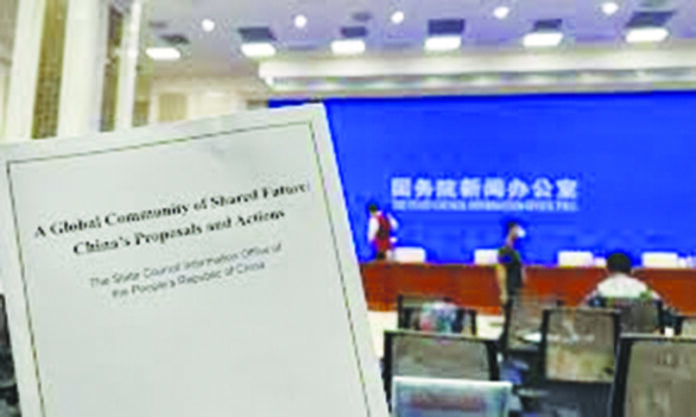In a strategic move, the Chinese government unveiled a groundbreaking white paper – a comprehensive blueprint for a global community of shared future. In this visionary document, entitled “A Global Community of Shared Future: China’s Proposals and Actions,” China defines the way towards a world order characterized by greater harmony and cooperation.
Amidst a global landscape undergoing profound transformations, China’s articulation of its vision challenges the prevailing hegemonic ambitions of a few select nations. The paper underscores the critical necessity to transcend the outdated and counterproductive zero-sum mindset, which only serves to undermine global stability.
China’s vision for a global community of shared future offers a refreshing alternative, emphasizing cooperation, mutual benefit, and a commitment to solving the unprecedented challenges confronting humanity. By embracing this perspective, the world can forge a path towards a more equitable and prosperous future. In this pivotal moment in history, the world finds itself at a crucial juncture, facing the age-old dilemmas of unity versus division, openness versus isolation, and cooperation versus confrontation, as articulated in the white paper.’
It prompts the global leaders to reflect on the essence of the global community of shared future and how nations can collaborate effectively in its construction. These questions challenge the collective wisdom of countries worldwide, inviting them to seek common ground and shared solutions in order to navigate the complex challenges of our time.
Certain nations, regrettably, remain entrenched in a self-defeating pursuit of absolute dominance and monopolistic advantages. This approach, as elucidated in the white paper, not only hinders their own long-term progress but also poses a grave threat to global security and prosperity.
In the last decade, China has wholeheartedly devoted its resources and resolve to foster a global community of shared future. During this period, the vision of such a community has garnered wider endorsement. Countries and individuals increasingly recognize that this vision aligns with the collective well-being of humanity. It echoes the universal desire for peace, justice, and advancement, and promises to harness the combined strength of all nations to construct a superior world, as emphasized in the white paper.
A mere decade ago, China articulated its vision for international relations, encapsulated in the concept of a “community of shared future for mankind” or, in contemporary terms, a “global community of shared future.” Today, we witness the remarkable realization of a world characterized by global cooperation, security, prosperity, and the flourishing of inter-civilizational dialogue. In a rather short span, this vision has blossomed into reality.
The emergence of multipolar and multilateral global partnerships and organizations, such as BRICS, the Group of 77, the Shanghai Cooperation Organization, and ASEAN, stands as a testament to this transformation. China has been playing an active role in supporting and nurturing these entities to carve a new world order founded on the principles of harmonious coexistence among all nations. The vision of a global community of shared future aligns with the course of history and human advancement. It offers a fresh paradigm for international relations, innovates global governance concepts, fosters international collaboration, and sketches a promising blueprint for a more prosperous world, as outlined in the white paper.
The concept of a global community of shared future is deeply rooted in China’s rich cultural heritage and its unique experience of modernization. It represents an evolution of China’s diplomatic traditions, drawing inspiration from the remarkable achievements of various civilizations. Furthermore, it embodies China’s enduring historical customs, reflects the spirit of our times, and encompasses a wealth of humanistic values. The white paper outlines a clear path for building this global community of shared future. It emphasizes the importance of advancing a new form of economic globalization, where nations must champion openness while vehemently opposing protectionism, the erection of trade barriers, unilateral sanctions, and aggressive maximum-pressure tactics
Such an approach aims to foster economic interconnectivity and jointly cultivate an open global economy, emphasizing collaboration over competition. The white paper lays out a comprehensive roadmap that includes embracing a peaceful development strategy, nurturing a novel approach to international relations, championing authentic multilateralism, and advancing the shared values of our global community. Over the last decade, China has demonstrated unwavering commitment and concrete actions in contributing to the establishment of a global community of shared future.
A telling example of this commitment is the Belt and Road Initiative (BRI), which, by July 2023, had garnered support from over three-quarters of nations worldwide and more than 30 international organizations. While the BRI originated in China, its benefits are extended to the entire world. This initiative prioritizes economic cooperation over geopolitical or military alliances and maintains an open, inclusive process that welcomes all without discrimination, as highlighted in the white paper.
In addition to the Belt and Road Initiative (BRI), China’s Global Development Initiative, Global Security Initiative, and Global Civilization Initiative have emerged as pivotal pillars for constructing a global community of shared future. These initiatives present China’s innovative approaches to addressing the critical issues of peace and development that confront humanity. Confronted with persistent hotspots across the globe, China has remained dedicated to its role as a responsible major player, actively advocating for the resolution of international and regional flashpoints, including but not limited to the Korean Peninsula, Ukraine conflict, Palestine, the Iranian nuclear question, Syria, and Afghanistan, as outlined in the white paper. China does not just talk the talk; it walks the walk by translating its proposals into concrete actions, yielding significant global accomplishments, as evident by recent Saudi-Iran détente.
In the last decade, China has wholeheartedly devoted its resources and resolve to foster a global community of shared future. During this period, the vision of such a community has garnered wider endorsement. Countries and individuals increasingly recognize that this vision aligns with the collective well-being of humanity. It echoes the universal desire for peace, justice, and advancement, and promises to harness the combined strength of all nations to construct a superior world, as emphasized in the white paper.























